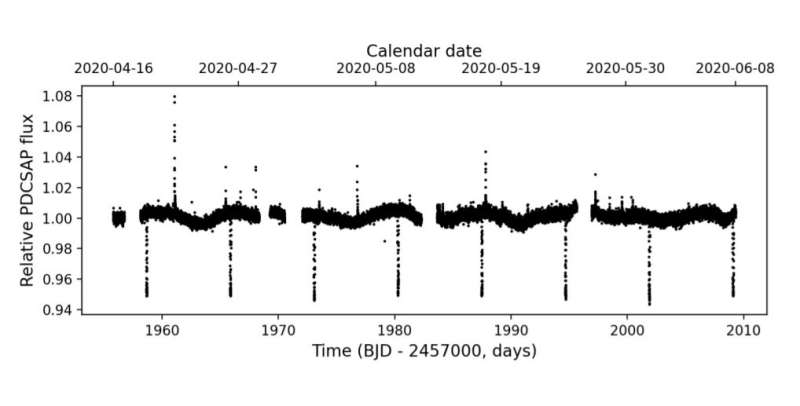February 28, 2022 report
New brown dwarf discovered with TESS

Using NASA's Transiting Exoplanet Survey Satellite (TESS), an international team of astronomers has detected a new brown dwarf. The newly found object, designated TOI-2119b, turns out to be about the size of Jupiter but over 60 times more massive than the solar system's biggest planet. The discovery is reported in a paper published February 17 on arXiv.org.
Brown dwarfs are intermediate objects between planets and stars, occupying the mass range between 13 and 80 Jupiter masses. Although many brown dwarfs have been detected to date, such objects orbiting other stars are a rare find.
Now, a group of astronomers led by Theron W. Carmichael of the University of Edinburgh, UK, reports the finding of another rare brown dwarf transiting an M-dwarf star. To date, only eight such systems have been detected.
Carmichael's team have employed TESS to observe a nearby active M dwarf known as TOI-2119 (other designation TIC 236387002), which is located some 103.7 light years away from the Earth. A transit signal was found in the light curve of this star and a follow-up observational campaign has confirmed the brown dwarf nature of this signal.
"The TESS mission produced the light curves for TOI-2119 with a two-minute cadence in sector 24 from April 16, 2020 to May 12, 2020 and in sector 25 from May 14, 2020 to June 2020. A transit signature with a 7.2-day period was identified in the Science Processing Operations Centre (SPOC) transiting planet search of the light curves in both sectors. This SPOC detection was subsequently promoted by the TESS Science Office to TESS Object of Interest (TOI) status as TOI 2119.01 based on the clean transit model fit and diagnostic test results in the SPOC data validation report," the researchers explained.
TOI-2119b has a radius of about 1.08 Jupiter radii, while its mass is estimated to be 64.4 Jupiter masses. It orbits its host star every 7.2 days, at a distance of some 0.06 AU from it. The orbit of this brown dwarf has an eccentricity at a level of 0.337 and is inclined 88.4 degrees. The effective temperature of this object was calculated to be 2,030 K.
The parent star TOI-2119 is approximately half the size and mass of our sun. It has a luminosity at a level of nearly 0.04 solar luminosities and an effective temperature of 3,621 K. Its age is estimated to be some 2.14 billion years. The astronomers added that the discovery makes TOI-2119 one of the most active M-dwarf stars known to host a transiting brown dwarf.
Summing up the results, the authors of the paper concluded that TOI-2119b may have formed in an eccentric, close-in orbit, or it may currently be undergoing a quick inward migration from a farther out formation distance that will take billions of years to complete. They underlined that both scenarios may be equally plausible and further investigation of this system is needed in order to confirm which one is true.
More information: Theron W. Carmichael et al, TOI-2119: A transiting brown dwarf orbiting an active M-dwarf from NASA's TESS mission. arXiv:2202.08842v1 [astro-ph.SR], arxiv.org/abs/2202.08842
© 2022 Science X Network




















